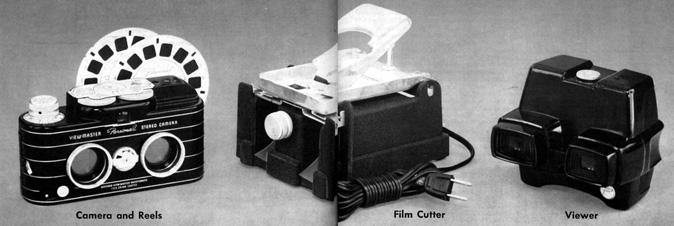The following is an article that originally appeared in Modern Photography magazine, August 1955, pp. 86-89, and pp.103-104. It was written by Norman Rothschild.
How Practical is the View-Master System?
Here's a really unique system of 3-D photography. MODERN examines every item,
makes a frank report on how each works.
The word unique is ohen erroneously applied to about every new piece of photographic equipment made. But this word precisely describes the Sawyer's View-Master Personal Stereo system. The camera is unique, the method of mounting the stereo pairs is unique, and almost every piece of equipment for the system is unique.
The Personal Stereo system is not new. Actually, both camera and film cutter have been available for a number of years. But it's only recently that a sufficiently good stereo hand viewer has been available, equal in quality with the rest of the system. Previously, the only viewer available was a $2 instrument, more in the nature of an educational toy. Consequently, Modern had held up any opinions on the system pending the arrival of the long-promised viewer. Now the system is intact.
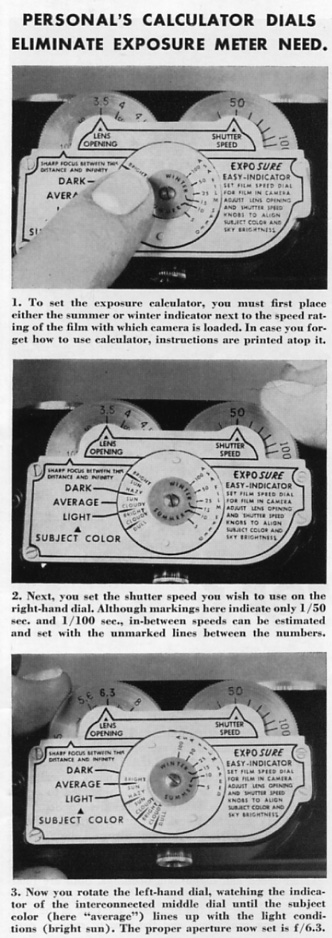 The View-Master Stereo system started out with only a viewer for which commercially made travelogue, cartoon and story-telling 3-D reels
were available. Each cardboard circular reel held 7 pairs of stereo shots, actually made with a 2¼ x 2¼-in., or larger,
stereo camera, which were reduced in processing to approximately 12 x 14mm for insertion in the Sawyer's stereo reels. Sawyer's decided
to design a camera for amateurs to make stereo pairs in this size. And that's how the unique camera ($89.50) came to be designed.
The View-Master Stereo system started out with only a viewer for which commercially made travelogue, cartoon and story-telling 3-D reels
were available. Each cardboard circular reel held 7 pairs of stereo shots, actually made with a 2¼ x 2¼-in., or larger,
stereo camera, which were reduced in processing to approximately 12 x 14mm for insertion in the Sawyer's stereo reels. Sawyer's decided
to design a camera for amateurs to make stereo pairs in this size. And that's how the unique camera ($89.50) came to be designed.
Although each View-Master stereo picture measures 12 x 14mm, the camera is designed to use regular 35mm film cartridges. With a standard 20-exposure roll of film (not a "stereo roll"), stereo pairs are first made along the bottom half of the film as this film is wound from the cartridge onto the takeup spool. Then a knob on the front of the camera is turned, and the lenses, which are set behind the shutters in small, vertical elevators, rise to transmit images along the top half of the film as it is rewound into the original cartridges. You can make 37 stereo pairs on a standard 20-exposure roll and 69 stereo pairs from a 36-exposure roll.
The lenses are fixed-focus 25mm f/3.5 with stops to f/16. At f/3.5, the depth of field, or zone of sharp focus, extends from 6 feet to infinity. At f/16, the depth extends from 4 feet to infinity. The lenses are located behind the shutters, which are of a guillotine type with speeds of 1/10, 1/15, 1/25, 1/50, 1/100 sec. and bulb. The shutters are protected in front by plain, optical glass. The front of each shutter mount is threaded to accept Series V accessories. Retaining rings are supplied.
Besides the unusual device of using vertically sliding lenses and producing such small pictures, the Sawyer's instrument has another interesting feature, the exposure computer dials atop the camera. The two dials control shutter speed and diaphragm openings. Both are interconnected with a dial in the middle which indicates the ASA Speed Index of the film used, the time of the year, the lighting conditions, and the type of subject, dark, average or light. By properly positioning the center dial atop the camera, you automatically set the correct lens opening and shutter combinations. And the exposure dials are constructed in such a way that you can set your shutter speed first and then automatically find the proper lens opening, or you can set the lens opening and automatically find the proper shutter speed.
Here are other important camera features. A bubble level to help keep the camera at an even keel is visible through the viewfinder. Winding the film automatically cocks the shutters. The all-metal alloy body has a hinged back. There are various safety devices to prevent you from opening the camera back at the wrong time. The shutters are synchronized for all flashbulbs at 1/25 sec, and electronic flash at all speeds.
Before we discuss the camera more, let's look at the rest of the View-Master system.
Processing and mounting
Once you've shot the last of the 37 or 69 stereo exposures, you must get the film processed. Since the Personal stereo pictures are far smaller than standard 2-D or stereo transparencies, processing labs do not have the facilities for mounting them. Instead, you must specify that the lab return the film to you, without mounting, in one uncut strip. Then you can send the strip to Sawyer's, who will mount a 37 pair roll for $2.25 or a 69 pair roll for $3.45, or you easily can mount the stereo pairs in reels yourself with the Sawyer's Film Cutter ($14.75). The cutter, which illuminates each pair of transparencies from underneath, die-cuts each stereo pair from the strip. The small transparencies are then slid into empty slots in the Personal reels. And when mounted, the stereo shots are not only ready for hand viewing, but are also properly mounted for projection.
The completed reels can be enjoyed in two different hand viewers, projected in stereo with the Stereomatic 500 3-D projector, or projected as single frames with either of two non-stereo projectors.
T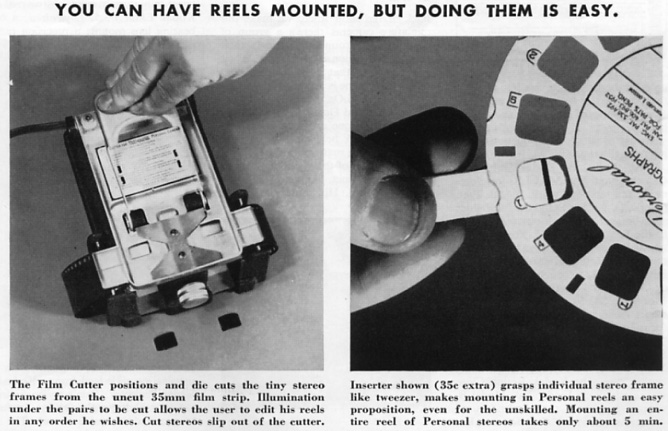 he two viewers
he two viewers
The cheaper of the two hand viewers is the $2 item originally designed to view the commercially-made View-Master reels. It's of an all-plastic construction, with no built-in light source. There are no focusing or inter-ocular adjustments. And the image is quite small—you feel as if you are looking at a scene through a long length of pipe. A separate, easily-fitted battery-powered light source is available for $2 additional.
The Deluxe Viewer has focusing lenses, a battery-powered light source, but no inter-pupillary adjustment. However, the lenses are relatively large in diameter and none of 20 people to whom the viewer was shown had any trouble fusing the images. The picture as seen in this viewer is considerably larger and sharper than that seen in the inexpensive viewer.
The camera cutter and viewers are the basic units in the Personal System of stereo. How good are they, and how do they compare in quality with the "standard" stereo of 23 x 24mm each frame?
The smaller frame size of the Sawyer's system does allow you to produce stereo pairs far more cheaply than any other system. In fact, the prospect of shooting 69 complete stereo pairs before you can take the film from your camera is almost frightening. (Sawyer's recommends the 20-exposure roll). The small size of the picture needs a lens of extremely short focal length (25mm). Focusing is really unnecessary. In all pictures made at maximum opening, sharpness was easily maintained from 6 feet to infinity. The shutter release presses easily, although the shutter itself is slightly noisy. Lack of speeds over 1/100 sec. may limit the camera's use for action stereo.
Unlike any other stereo camera, the Personal doesn't need to have film rewound into its original cartridge after you've shot the last stereo picture. The film rewinds into the cartridge as you're exposing the upper half of the film. When you've finished the last picture, you can give the wind knob a twist more and your film is ready to be removed from the camera.
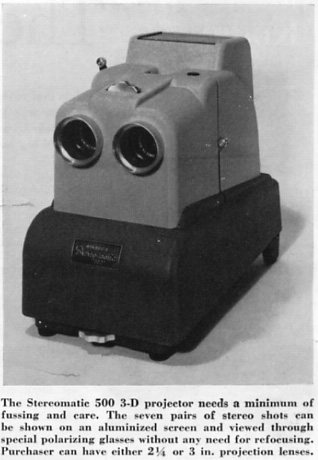 The Automatic 500 3-D projector ($119.50) is probably the simplest of all stereo projectors to operate. It has a 500-watt lamp,
two matched 2 ¼ or 3 in. f/3 lenses and focuses by a milled wheel. Naturally, a special aluminized screen and polarizing glasses
are needed for viewing. To focus the projector, you simply insert an empty Personal reel, turn on the projector lamp, and line up
the two projected squares of light so that their sides are vertical. You're then ready for projection. No horizontal adjustment is
needed, and the lever for optical adjustments need only be used if the stereo pairs are mounted incorrectly. Focusing need not be
changed during a stereo show unless you switch from home-made stereos to the commercially made ones. In such a case, the difference
in thickness between the two types of reels can he compensated for by turning the focusing knob four notches.
The Automatic 500 3-D projector ($119.50) is probably the simplest of all stereo projectors to operate. It has a 500-watt lamp,
two matched 2 ¼ or 3 in. f/3 lenses and focuses by a milled wheel. Naturally, a special aluminized screen and polarizing glasses
are needed for viewing. To focus the projector, you simply insert an empty Personal reel, turn on the projector lamp, and line up
the two projected squares of light so that their sides are vertical. You're then ready for projection. No horizontal adjustment is
needed, and the lever for optical adjustments need only be used if the stereo pairs are mounted incorrectly. Focusing need not be
changed during a stereo show unless you switch from home-made stereos to the commercially made ones. In such a case, the difference
in thickness between the two types of reels can he compensated for by turning the focusing knob four notches.
Images up to 40 in. square, quite sufficient in size for a home showing, can be projected witli brilliance. The Sawyer's projection system requires far less work, eye-strain, or adjustment than any other system available.
If you don't want to project 3-D stereo, but still want to see your shots on a screen, there are the two other 2-D projectors. The Junior Projector ($9.95) has an f/3 doublet lens, plastic construction, and a maximum screen image of about 20 in. The S-1 projector ($44.50) has an f/3 coated anastigmat lens, aluminum body. Images up to 36 in. square can be projected with adequate brightness.
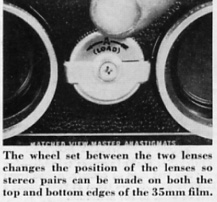 There are a few other important accessories. Two closeup attachments ($9.75 a set) allow you to focus the Personal camera as close as 24 or 36 in. The attachments include parallax correcting prisms for the viewfinder.
There are a few other important accessories. Two closeup attachments ($9.75 a set) allow you to focus the Personal camera as close as 24 or 36 in. The attachments include parallax correcting prisms for the viewfinder.
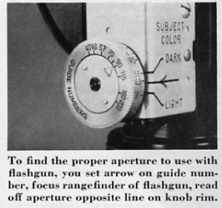 The flash unit ($14.75). which screws directly into the top of the Personal camera, is a fascinating instrument. It has its own rangefinder. When you focus
on your subject, the dial on the flashgun measures the subject distance and divides it into the flashbulb guide number.
The flash unit ($14.75). which screws directly into the top of the Personal camera, is a fascinating instrument. It has its own rangefinder. When you focus
on your subject, the dial on the flashgun measures the subject distance and divides it into the flashbulb guide number.
Any comparison of the View-Master stereo system with others must take into consideration the intent of the manufacturer in offering his product. As the name "Personal" implies, the system is specifically designed for amateur, "personal" use with virtually foolproof operation and economy.
The small stereo pairs make focusing errors impossible and the simple exposure calculator dials help eliminate poorly exposed stereo pairs. The viewers are inexpensive. 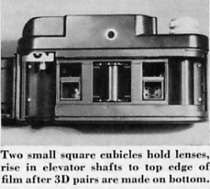 The stereo projection system is the simplest yet encountered. The amount of sharpness achieved in projected or hand-viewed 12 x 14mm stereo
pairs is amazing, although it does suffer in comparison with slides of the far-more-expensive-to-produce 23 x 24mm format stereo. Because the focal length of the lenses used in the camera is considerably longer than the diagonal of the film, the stereo effect is reduced slightly. Thus pictures have a more real,
less waxen, dummy appearance than stereo pictures produced in more conventional systems. The Sawyer's View-Master Personal Stereo system is ideally suited for home use. The individual units, camera, cutter, viewers, and projectors show an ingenuity of design, a sturdiness of manufacture, and reliability in six
months of tests that few other samples of photographic equipment have ever matched.—the end
The stereo projection system is the simplest yet encountered. The amount of sharpness achieved in projected or hand-viewed 12 x 14mm stereo
pairs is amazing, although it does suffer in comparison with slides of the far-more-expensive-to-produce 23 x 24mm format stereo. Because the focal length of the lenses used in the camera is considerably longer than the diagonal of the film, the stereo effect is reduced slightly. Thus pictures have a more real,
less waxen, dummy appearance than stereo pictures produced in more conventional systems. The Sawyer's View-Master Personal Stereo system is ideally suited for home use. The individual units, camera, cutter, viewers, and projectors show an ingenuity of design, a sturdiness of manufacture, and reliability in six
months of tests that few other samples of photographic equipment have ever matched.—the end
